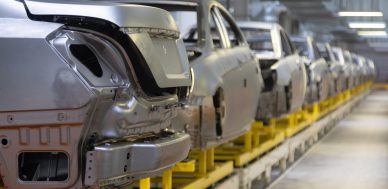U.S. Automakers Could Face a Lot of Headwinds
U.S. automakers could be in a lot of trouble.
After the financial crisis of 2008–2009, automakers had a great time. Interest rates were low and consumers could borrow a lot. This created a lot of demand for cars.
Now, things are not so great on the lending end.
Look at the chart below. It plots the year-over-year change in auto loans in the United States.
Prior to 2015, auto loans were growing around nine percent. Now this rate is just around four percent. In other words, the auto loans growth rate has dropped by more than 50%.
(Source: “Motor Vehicle Loans Owned and Securitized, Outstanding,” Federal Reserve Bank Of St. Louis, last accessed September 9, 2019.)
What do you think will happen as lending drops? Car sales will come down. U.S. automakers, it seems, are preparing for the worst.
Look at another chart below; it plots U.S. domestic auto production.
In the third quarter of 2015, U.S. automakers produced 362,300 vehicles. In the second quarter of 2019, they produced 207,100 vehicles. Simple math here: auto production has dropped 43% over the past several quarters.
(Source: “Domestic Auto Production,” Federal Reserve Bank of St. Louis, last accessed September 9, 2019.)
That’s not all; when businesses expect slow demand, they tend to reduce their inventories. There’s no point in increasing inventories when you know you can’t sell them.
Look at another chart below; it plots how many vehicles are in inventory in the United States.
In the second quarter of 2017, domestic auto inventories in the U.S. were almost 1.2 million units. In the second quarter of 2019, auto inventories stood at 639,700 units. This represents a decline of 44% in inventories in matter of a few quarters.
Based on that, it seems that automakers are preparing for something bad.
(Source: “Domestic Auto Inventories,” Federal Reserve Bank of St. Louis, last accessed September 5, 2019.)
If U.S. Carmakers Suffer, It won’t Be Good for Jobs or Investors
Why worry about all this? You see, dear reader, automakers employ a lot of Americans.
Look at the final chart below; it plots the number of Americans working at automakers and auto parts makers.
(Source: “All Employees: Durable Goods: Motor Vehicles and Parts,” Federal Reserve Bank of St. Louis, last accessed September 9, 2019.)
As of July 2019, over one million American worked for companies producing cars or car parts.
If automakers run into trouble, you have to wonder what will happen to all those Americans working for them. Don’t you think it would have a negative spin-off effect on the entire U.S. economy?
Carmakers struggling could be bad for investors who own shares in those companies. If automakers face headwinds, will their stock prices remain the same? It’s very unlikely. In fact, it wouldn’t be wrong to say that their shares could come under fire and be sold off.
As I said earlier, this is very alarming. There’s something bad brewing at American automakers and it won’t end well. Investors need to be very careful.
